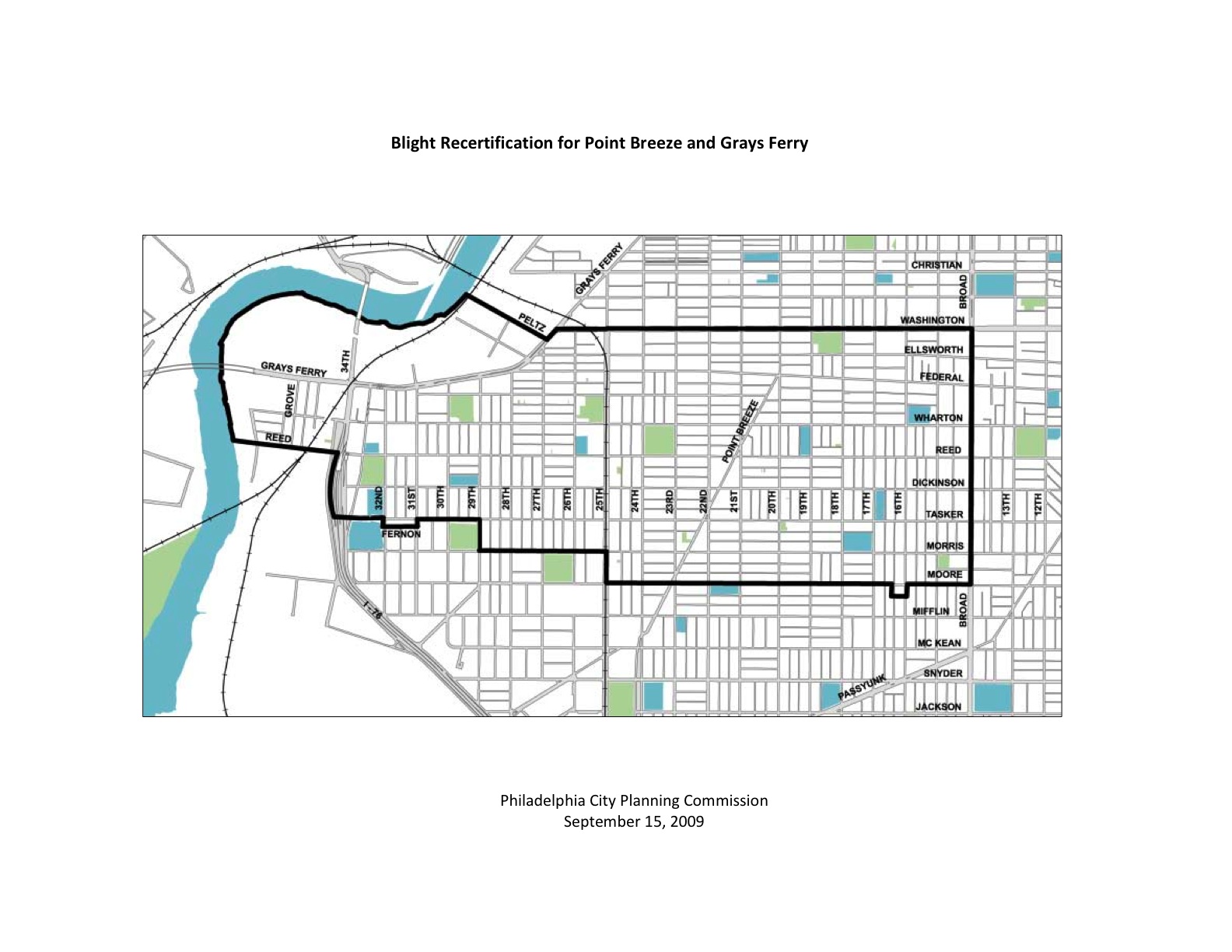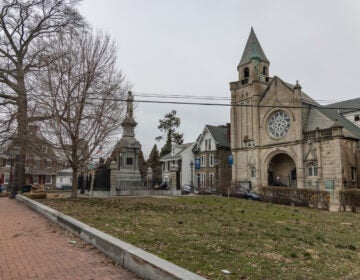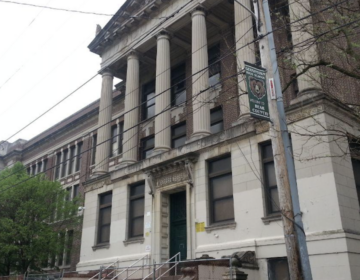Blight Plan: Point Breeze, Gray’s Ferry re-certified

Sept. 15
By Thomas J. Walsh
For PlanPhilly
The Point Breeze and Gray’s Ferry sections of southwest Philadelphia, riddled with urban decay, declining populations and an increasing vacancy rate, were re-certified as officially blighted by the Philadelphia City Planning Commission Tuesday.
The agency also approved new design guidelines for the North Delaware Riverfront Greenway (to be a part of the East Coast Greenway system), approved amendments to the fiscal year 2010-2015 capital program and the fiscal year 2010 capital budget and gave the go-ahead for two neighborhood redevelopment projects.
Community planner David Knapton presented the details on the blight recertification plan for Point Breeze and Gray’s Ferry – an area roughly from Washington Avenue south to Moore Street and from Board Street west to the Schuylkill River. The new blight certification was requested by the Redevelopment Authority to keep ongoing plans in place and to remain eligible for certain state and federal funding.
Knapton said that a redevelopment area plan is in the works and might be ready for Commission approval by November. Under “Pennsylvania Urban Redevelopment Law”, at least one of seven criteria must be met for an area to be certified as blighted. It met two of the seven by having “unsafe, unsanitary, inadequate or overcrowded conditions” and “economically or socially undesirable land use.”
The neighborhoods together have almost 2,000 vacant lots, more than 5,000 building code violations (most by neglect and deferred maintenance) and deteriorating infrastructure – notably the 25th St. rail viaduct, which Knapton said was crumbling, with concrete falling to the streets and sidewalks below. Property values are much less in the neighborhoods than the city median home value.
All of which “deters reinvestment,” Knapton said. “It’s hard to find a block that’s not been affected. Nearly 12 percent of the properties in the neighborhoods are vacant lots.”
North Delaware Greenway
Mike Thompson, a Northeast Philadelphia community planner, presented the document that “sets forth design criteria of the North Delaware Trail and will guide construction of a recreational trail. When completed, the trail will become part of the East Coast Greenway – a planned, continuous greenway stretching along the east coast of the U. S. from Maine to Florida.”
The greenway will stretch from Allegheny Avenue north to the Bucks County line at the mouth of the Poquessing Creek, at Glen Foerd – about 11 miles of Delaware riverfront land that touches on the neighborhoods of Port Richmond, Bridesburg, Wissanoming, Tacony, Mayfair, Holmesburg, Torresdale, Morrell Park, Millbrook and Parkwood.
The guidelines, produced with the help of Lager Raabe Skafte Landscape Architects, Inc., are a result of the Delaware River Conservation District Bill approved by the Commission in May and includes a 50-foot setback from the river’s edge. Most paths will be either paved or use a boardwalk surface, with a minimum 12-foot width and in many spots as wide as 18 feet. The trails will have restrooms, lighting, water fountains, trash receptacles and other amenities.
Working with the Planning Commission staff, the Streets Department will be responsible for the roadside paths, Fairmount Park will have construction oversight, and the Delaware River City Corp. (working with the Pennsylvania Environmental Council) will perform trail maintenance.
“These type of trails do promote development along them,” said Commissioner Natalia Olson Urtecho. She asked DRCC Director Paul Lonie if he has seen any progress on that front.
“Yes,” Lonie said. In just the past month, three different developers have contacted him expressing an interest in selling their land.
Craig Schelter, a consultant who runs represents a group of riverfront developers, wanted to know what the costs of the new standards are.
“In light of the fact that the mayor … on August 19 signed the legislation for the Central Delaware waterfront, and the Planning Commission is going to work on standards for the Central Delaware, I’m curious as to what the cost are for these standards here,” he said, citing per linear foot prices, or per acre or mile.
“It’s something developers can get a look at to know whether in fact projects can sustain the costs, or if they can’t, how the money can be provided to ensure that these are built at that level.”
“We have three section of trail in preliminary design,” Lonie said. By later this year or early next year, when the projects go out for bid, “we’ll have a much better estimate of how much the trail costs will be.”
“It’s a fair question, and obviously we don’t have those answers,” said Planning Commission Executive Director Alan Greenberger. “I think the Central Delaware will be somewhat of a different situation.” In the central part of the waterfront, they’re dealing with many piers and other infrastructure, he said. On the northern end, costs could be lower because of the “large swaths of land” involved.
After the meeting, Schelter remained frustrated. “Is it responsible for the Commission to adopt standards without knowing the costs?” he said, shaking his head.
Lonie’s organization is in the process of choosing an engineering consultant for the project, and road construction is scheduled to start next spring.
Meanwhile, the “North Delaware Greenway Gaps Feasibility Study” is to be released later this month. The study will “help advance implementation of the greenway by evaluating the feasibility of potential alignments for the trail through particularly challenging sections,” according to a Planning Commission staff report. “Community groups have provided consistent support for the greenway and have endorsed recreational redevelopment as well as all recent greenway trail mixed-use residential/commercial redevelopment plans.
Other business
The Commission approved a redevelopment agreement with the Nicetown Community Development Corp. for a 1.25-acre mixed-use development at Germantown Avenue and Dennie Street, on vacant land in an urban renewal area.
The $14.7 million project, with $9.6 million in government assistance (including a $2.8 million loan from the city) would yield 37 low- to moderate-income rental housing units and 3,403 square feet of ground floor retail space.
The Commission also approved, with numerous infrastructure conditions, a revised plan to build a small subdivision of seven homes on Cinnaminson Street in Northwest Philadelphia’s Germany Hill neighborhood.
Contact the reporter at www.ThomasJWalsh.info.
WHYY is your source for fact-based, in-depth journalism and information. As a nonprofit organization, we rely on financial support from readers like you. Please give today.





